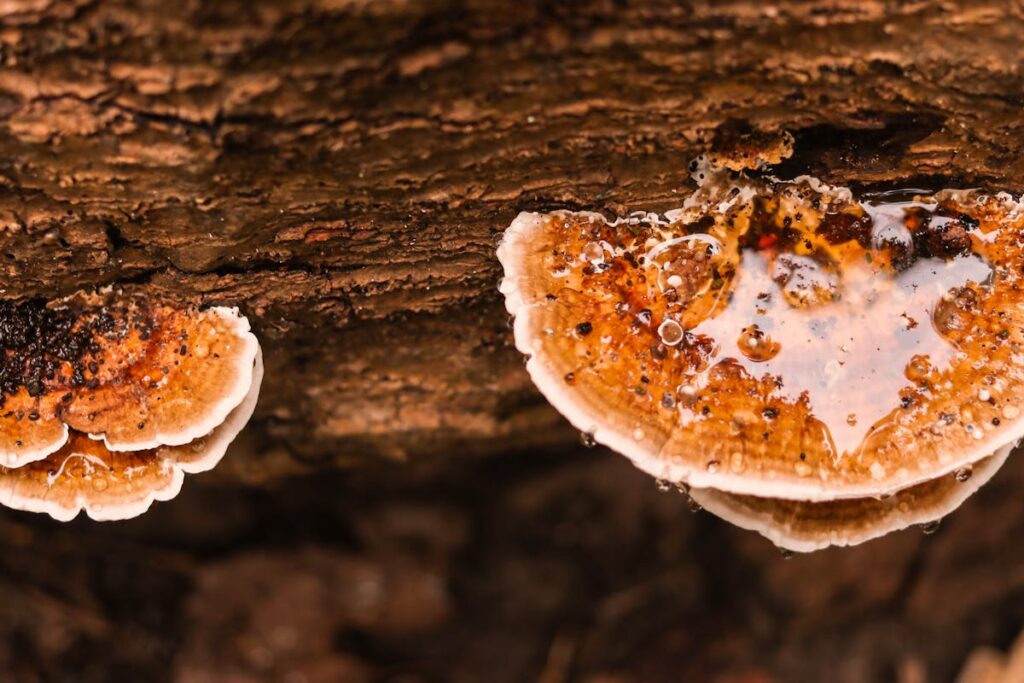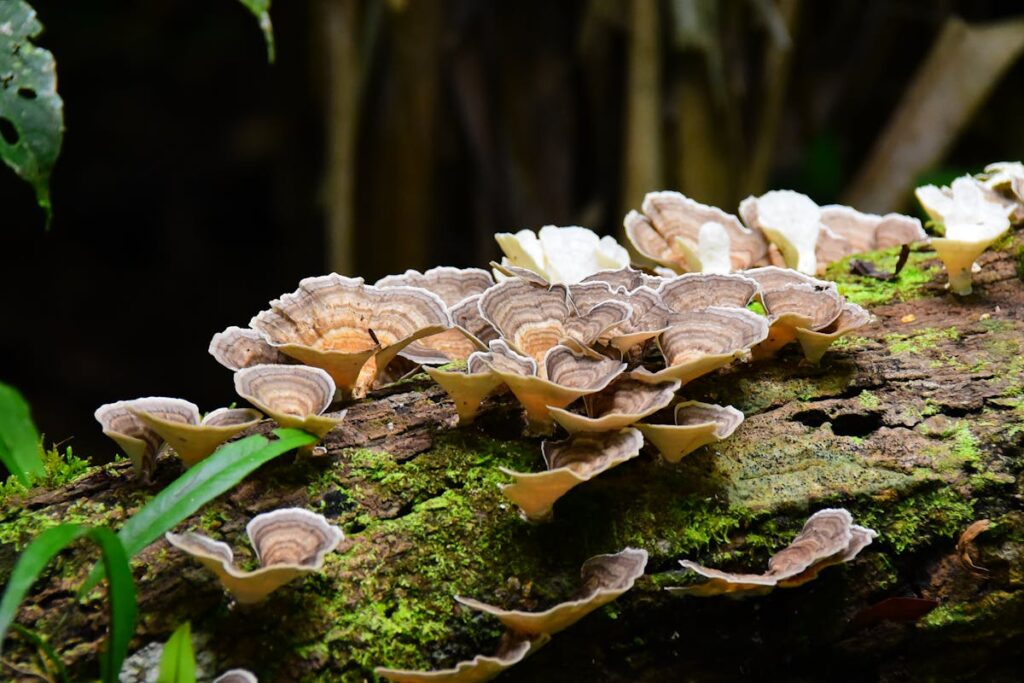Your cart is currently empty!
Fungal ‘Brains’ Can Think Like Human Minds, Scientists Say

What if intelligence isn’t limited to neurons and brains? What if cognition exists in forms we’ve barely begun to understand? Fungi are often dismissed as simple organisms, but they may be far more sophisticated than they seem. New research suggests these mysterious life forms can make decisions, solve problems, and communicate across vast underground networks. Without a brain, fungi still exhibit behaviors that resemble intelligence, challenging the very definition of what it means to think.
Fungi Can Solve Problems
Scientists tested whether fungi exhibit intelligence by observing how they navigate obstacles. In a controlled experiment, researchers placed fungal colonies in environments with physical barriers and structured block patterns designed to challenge their natural growth. Instead of spreading randomly, the fungi adapted, extending their mycelial networks strategically to conserve energy while maximizing resource access.
Researchers from Tohoku University and Nagaoka College explored fungi’s decision-making processes, including Yu Fukasawa, Kosuke Hamano, Koji Kaga, Daisuke Akai, and Takayuki Takeh. Fukasawa, a lead researcher, highlighted their remarkable adaptability, stating, “You’d be surprised at just how much fungi are capable of.” Their study, “Spatial Resource Arrangement Influences Both Network Structures and Activity of Fungal Mycelia: A Form of Pattern Recognition?” examines how fungi respond to environmental conditions, raising intriguing questions about their cognitive potential.
A Network That Thinks

Fungi rely on vast mycelial networks, thread-like structures beneath the surface, to process information. The article stated, “The mycelial network sometimes spreads over a large spatial scale of more than 900ha.” When one part of the network encounters a challenge, signals travel across the entire system, influencing how the rest of the fungus responds. This concept distributed intelligence, allows fungi to coordinate their actions without a central brain.
Like neurons transmit signals in a brain, mycelial networks pass information between distant fungal cells. If a path is blocked, the fungi “learn” and redirect growth elsewhere. These findings suggest that intelligence may not require a brain at all. It may emerge from biological, digital, or something in between networks.
Intelligence Beyond the Brain
Humans tend to associate intelligence with brains, neurons, and conscious thought. However, nature offers many examples of problem-solving without a central nervous system. Octopuses, for instance, have a form of distributed intelligence where each arm can process information independently, making decisions without waiting for input from the brain. Artificial intelligence works similarly, analyzing patterns and adapting based on past data without proper awareness.
Fungi take this concept even further. Without a single processing unit like a brain, they rely on their sprawling mycelial networks to sense, respond, and adapt to their environment. These underground networks behave like biological circuits, passing information across vast distances. When one part of the fungus encounters food, damage, or obstacles, signals spread throughout the system, influencing future growth decisions elsewhere.
Memory Without a Mind

Experiments have shown that fungi “remember” past experiences. When exposed to recurring obstacles, they modify their growth patterns, avoiding inefficient paths and favoring routes that previously led to success. Yu Fukasawa of Tohoku University stated, “Fungi have memories, they learn, and they can make decisions. Quite frankly, the way they solve problems compared to humans is mind-blowing.”
This adaptive behavior mirrors how organisms with nervous systems learn from trial and error. Some researchers suggest that the electrical impulses traveling through mycelial networks function similarly to neural activity, reinforcing that intelligence is not exclusive to animals.
The Science Behind Mycelial Networks and Decision-Making
Beneath the forest floor, fungi form intricate networks known as mycelium thread-like structures of microscopic filaments called hyphae. These hyphae spread through soil, wood, and decaying matter, acting as the fungus’s circulatory and nervous systems. While mushrooms are the visible reproductive structures, mycelium is the organism’s body, sometimes extending for miles. More than just a growth system, mycelium functions as a communication network, allowing fungi to transmit signals and respond to their environment. Through electrical impulses and chemical exchanges, fungi share information across their hyphal networks, similar to neurons transmitting messages in the brain. When one part of the mycelium encounters food, toxins, or an obstacle, the entire network adjusts accordingly, ensuring the organism makes the best possible decisions for survival.
Researchers have found that fungi also modify their network structures depending on spatial resource distribution. The press release states, “For the cross arrangement, the degree of connection was greater in the outermost four blocks. It was hypothesized that this was because the outermost blocks can serve as ‘outposts’ for the mycelial network to embark on foraging expeditions, therefore, more dense connections were required. In the circle arrangement, the degree of connection was the same at any given block. However, the dead center of the circle remained clear. It was proposed that the mycelial network did not benefit from overextending itself in an already well-populated area.”
Problem-Solving Without a Brain

Studies have shown that fungi can navigate complex environments with surprising efficiency. When faced with physical barriers, they don’t grow randomly; instead, they probe different paths and redirect their expansion to find the most efficient route. This strategic problem-solving extends to resource management, as fungi prioritize certain areas over others, directing energy toward the most promising food sources while conserving resources in less favorable regions. Even more intriguing, fungi seem capable of learning from past experiences. If they repeatedly encounter an obstacle or challenge, they adjust their future behavior, “remembering” which paths are worth exploring and which should be avoided. Author Yu Fukasawa stated, “This fungus, commonly used in studies of fungal behavior, has been reported to exhibit memory, learning, and decision-making abilities.” This ability to assess surroundings, adapt dynamically, and optimize growth patterns suggests a form of intelligence that operates without a central brain, challenging long-held assumptions about what it means to think and make decisions.
Implications for Science and Technology
The discovery of intelligence-like behavior in fungi opens doors to groundbreaking applications in various fields, from artificial intelligence to environmental sustainability. Fungi operate through decentralized decision-making, a principle that could inspire new approaches in AI and robotics. Unlike traditional AI models that rely on centralized processing, fungal intelligence demonstrates how complex problem-solving can emerge from straightforward, interconnected units. This could lead to advancements in swarm robotics, where groups of autonomous robots work together like mycelial networks to navigate obstacles, optimize resources, and adapt in real-time.
Beyond technology, studying fungal intelligence could reshape our understanding of cognition itself. Intelligence has long been associated with brains, but fungi challenge this notion by demonstrating problem-solving abilities without a central nervous system. Their ability to “learn,” store information, and make adaptive decisions suggests that intelligence might be a broader, more distributed phenomenon. This perspective could influence cognitive science, prompting researchers to explore unconventional forms of information processing in biological systems.
Fungal networks also offer promising solutions for environmental challenges. Mycelium naturally decomposes organic matter and has been shown to break down pollutants like plastics and heavy metals. Scientists are exploring ways to harness this ability for waste management, such as using fungi to clean up contaminated sites through a process known as mycoremediation. Additionally, mycorrhizal fungi species that form symbiotic relationships with plants can improve soil health, enhance crop resilience, and reduce the need for chemical fertilizers. As research into fungal intelligence expands, its applications could revolutionize technology and environmental conservation.
Practical Ways Fungi Influence Our Daily Lives
Fungi are more than just organisms hiding beneath the soil. They are vital to human health, food production, and environmental sustainability. Here are some of the most impactful ways fungi shape our daily lives:
- The Power of Fungal Antibiotics: Many life-saving drugs originate from fungi. Penicillin, the first widely used antibiotic, was derived from Penicillium mold, revolutionizing medicine by combating bacterial infections. Other antifungal and immunosuppressant drugs, such as cyclosporine (used in organ transplants), also come from fungal sources.
- Essential for Fermentation: Fungi drive the fermentation process that gives us bread, cheese, beer, and wine. Yeasts like Saccharomyces cerevisiae help bread rise and convert sugars into alcohol, while mold-based fungi contribute to the distinctive flavors of blue cheese and soy sauce.
- The Role of Psilocybin: Psilocybin, a compound found in certain mushrooms, has shown promise in treating depression, anxiety, and PTSD. Ongoing research suggests that psychedelic-assisted therapy with psilocybin could help reset neural pathways and improve mental health outcomes.
- Fungi as Natural Fertilizers: Mycorrhizal fungi form symbiotic relationships with plant roots, enhancing nutrient absorption and improving crop resilience. These fungi boost soil health, reduce dependence on chemical fertilizers, and support sustainable agriculture.
- Breaking Down Waste and Pollutants: Some fungi can decompose plastics, petroleum, and toxic chemicals, offering natural solutions for pollution control. Researchers are investigating ways to use fungi in waste management and ecological restoration, potentially reducing environmental damage.
Fungi Redefining Intelligence and Unlocking New Possibilities
Once overlooked as simple organisms, Fungi challenge our understanding of intelligence. Through their mycelial networks, fungi demonstrate complex problem-solving, resource management, and adaptability without a brain. This discovery forces us to reconsider the nature of cognition and intelligence itself, expanding the definition beyond the confines of the human brain.
As science continues to uncover fungi’s hidden capabilities, it encourages us to explore these fascinating organisms’ vast, untapped potential. From their role in medicine and food production to their impact on mental health and environmental sustainability, fungi are proving to be much more than just background players in nature. The more we study them, the more we realize how much they could teach us about life, intelligence, and the interconnectedness of all things.
